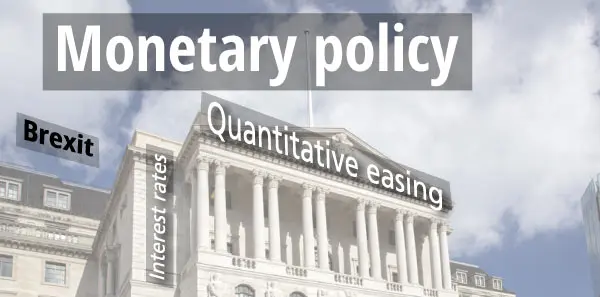Monetary policy changes

Bank of England cuts rate to 0.25%
As widely expected, the Bank of England cut official base rate for the first time since March 2009, from 0.5% to 0.25% – its lowest ever level. Governor Mark Carney had already given a clear indication that monetary policy would be loosened in the wake of the Brexit vote, as well as indicating that other measures might be considered if required.
The rate cut is a key element in the package of measures announced today (August 4th 2016), which includes:
- a 25 basis point cut in Bank Rate to 0.25%
- a new Term Funding Scheme (TFS) to reinforce the cut in Bank Rate, which will fund banks to help them pass on lower rates to their customers
- the purchase of up to £10 billion of UK corporate bonds, which the Bank hopes will provide a bigger stimulus than an equivalent amount used to purchase government assets (i.e. QE)
- the expansion of QE to purchase a further £60 billion of government bonds of £60 billion, taking the total stock of asset purchases to £435 billion
The last three aspects are to be financed by central bank reserves.
These measures were decided on August 3rd, and announced on August 4th.
The Bank of England has revised growth expectations downwards, and expects unemployment to rise from 4.9% to 5.5% within two years. The wider package is necessary given that, at very low rates, financial institutions may not necessarily pass-on these lower rates, and hence weaken any effect of a monetary stimulus.
The package announced today comes on the back of the first wave of data on the UK economy since the Brexit vote, including the sharpest fall in the outlook for service sector activity, since February 2009. Data from Markit/CIPS, shows that the purchasing manager’s index (PMI) for the service sector fell from 52.3 in June to 47.4 in July – the first contraction since December 2012. Other data also shows a Brexit effect, with the purchasing manager’s index (PMI) for manufacturing also down. The PMI, which tracks changes in output, new orders, employment and prices in all key sectors of the economy, is widely regarded as the most useful indicator of future changes to other key variables, including GDP.
However, some economists, including former MPC member, Marian Bell (interviewed on Sky News) have indicated that, while a monetary stimulus is necessary and timely, the surveys of business confidence were taken at a time of greatest uncertainty, even before a new government had been formed.
Statement by Mark Carney
Courtesy Euronews
Quantitative easing – how it works
Quantitative easing (QE) is a process whereby a Central Bank, in this case, the Bank of England, purchases existing government bonds (gilts) and (now) corporate bonds in order to pump money directly into the financial system. QE is often regarded as a last resort to stimulate spending in an economy when lower interest rates fail to work.
QE can work in a number of ways, but essentially it works by raising asset prices, starting with government bonds, and then spreading out through the wider economy – this gives a boost to bank assets and current bank lending and creates a positive wealth effect for asset holders.
The most immediate effect of the asset purchase is that prices of these existing assets rise, while yields – effectively, the interest on them – adjust downwards. This encourages banks and other investors to look to rebalance their portfolios by investing in other assets with a higher yield, such as corporate bonds and shares (equities). As new investment occurs, the new liquidity is re-directed towards sellers of bonds and shares. In addition, lower yields push down borrowing costs for business, which can act as a stimulus to borrowing and spending. The rise in the yields of other assets, such as shares, creates a wealth effect, with holders of assets experiencing an increase in their wealth, raising confidence and also stimulating spending. This positive effects of this may then spread out to the real economy.
Read more on QE
